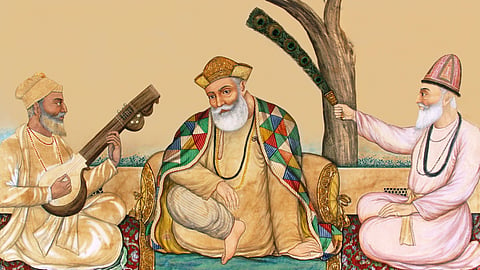
- Destinations
- Experiences
- Stay
- What's new
- Celebrating People
- Responsible Tourism
- CampaignsCampaigns
- SubscribeSubscribe
- Buy Now

Guru Nanak, the founder of Sikhism and the first of the ten Sikh Gurus, was an exceptional spiritual leader whose teachings continue to inspire millions worldwide. One of the most distinctive aspects of his life was his extensive travels, covering over 28,000 kilometres between 1500 and 1524. As a mystic and wanderer, he journeyed to far-flung places to spread his message of love, equality, and devotion to the divine.
On the occasion of Guru Nanak Jayanti 2024, we delve into his transformative journeys, exploring the places he visited and the profound impact he had on the communities he encountered.
During his early life, Guru Nanak worked for Daulat Khan Lodi in Sultanpur Lodhi. When he was 30 years old, he had a divine revelation while taking a bath in the Bein River. This experience marked the beginning of his spiritual journey. After three days of bathing in the river, he emerged and declared, "There is no Hindu, there is no Muslim." This statement laid the foundation for his message of oneness.
Sultanpur Lodhi is a town in the Kapurthala district of Punjab, where the mystic saint Guru Nanak spent 14 years of his life. The city is renowned for its historical gurudwaras, which are closely associated with the life of Guru Nanak. Visitors can immerse themselves in the serene surroundings of Gurdwara Ber Sahib, where Guru Nanak had a divine revelation under the historic Ber tree. The preserved mud-walled room at Gurdwara Sri Hatt Sahib reflects Guru Nanak's early life. The majestic Darbar Sahib is a spiritual centre for congregational prayers, while the historic Qila Sarai fort offers a glimpse into the town's historical past.
In the early 16th century, Guru Nanak embarked on a pilgrimage to the Muslim holy cities of Mecca and Medina. According to some accounts, he arrived in Mecca by sea and stayed in the city's graveyard for three days.
Guru Nanak's trip to Mecca and Medina is a powerful reminder of his commitment to building connections with people from diverse religious backgrounds. Despite coming from a Hindu background, he made a deliberate choice to visit Islam's most sacred cities. During his stay in Mecca, Guru Nanak engaged in profound spiritual conversations with Muslim scholars. He stressed the importance of devotion over ritualistic practices and highlighted the shared values between different faiths.
Although there is no historical evidence of a physical journey to Mount Sumeru, it holds great symbolic significance in Sikh tradition. This sacred mountain is revered in Hindu, Jain, and Buddhist cosmologies and represents a deep commitment to understanding and respecting diverse religious beliefs.
According to certain sources, Guru Nanak, a key figure in the Bhakti movement, is believed to have visited Mount Sumeru, also known as Mount Kailash, which is the centre around which the sun, planets, and stars orbit. It is said that Guru Nanak had a discourse with Gorakhnath Jogis, as well as Gorakhnath and his disciple at Mount Sumeru.
Guru Nanak is believed to have travelled to the far east as well. There is evidence in the Sikh scriptures that Guru Nanak visited Kamrup in Assam and travelled through Tibet, China, Japan, Java, and Sumatra. His interactions with the local communities aimed to promote unity and understanding, highlighting his efforts to reach out to people from various backgrounds. Although details of Guru Nanak's travels are not extensively documented, it is believed that they helped spread his message of peace and harmony beyond the borders of Punjab, where Sikhism originated.
Historical records indicate that Guru Nanak visited Sri Lanka, where he interacted with the local population and had a lasting impact on the religious landscape. His teachings emphasised the universal nature of spirituality, transcending geographical and cultural boundaries.
Guru Nanak visited Kurukshetra multiple times, emphasising righteous action and moral conduct. His travels aimed to break down barriers of religion, caste, and social hierarchy. The saint's teachings on the oneness of humanity continue to be central tenets of Sikh philosophy, preserved in the Guru Granth Sahib as a timeless guide for compassion, equality, and devotion.
